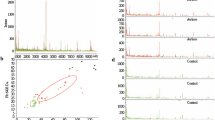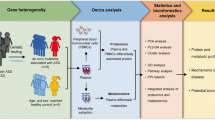Abstract
The pathophysiology of autistic spectrum disorder (ASD) is not fully understood and there are no diagnostic or predictive biomarkers. Proteomic profiling has been used in the past for biomarker research in several non-psychiatric and psychiatric disorders and could provide new insights, potentially presenting a useful tool for generating such biomarkers in autism. Serum protein pre-fractionation with C8-magnetic beads and protein profiling by matrix-assisted laser desorption/ionisation-time of flight-mass spectrometry (MALDI-ToF-MS) were used to identify possible differences in protein profiles in patients and controls. Serum was obtained from 16 patients (aged 8–18) and age-matched controls. Three peaks in the MALDI-ToF-MS significantly differentiated the ASD sample from the control group. Sub-grouping the ASD patients into children with and without comorbid Attention Deficit and Hyperactivity Disorder, ADHD (ASD/ADHD+ patients, n = 9; ASD/ADHD− patients, n = 7), one peak distinguished the ASD/ADHD+ patients from controls and ASD/ADHD− patients. Our results suggest that altered protein levels in peripheral blood of patients with ASD might represent useful biomarkers for this devastating psychiatric disorder.


Similar content being viewed by others
References
Achenbach TM, Edelbrock CS (1981) Behavioural problems and competencies reported by parents of normal and disturbed children aged four through sixteen. Monogr Soc Res Child Dev 46(1):1–82
Belmonte MK, Cook EH Jr, Anderson GM, Rubenstein JL, Greenough WT, Beckel-Mitchener A, Courchesne E, Boulanger LM, Powell SB, Levitt PR, Perry EK, Jiang YH, DeLorey TM, Tierney E (2004) Autism as a disorder of neural information processing: directions for research and targets for therapy. Mol Psychiatry 9(7):646–663
Boelte S (2006) PF. FSK—Fragebogen zur Sozialen Kommunikation. Huber, Bern
Boelte SRD, Schmoetzer G, Poustka F (2006) ADI-R—Diagnostisches Interview fuer Autismus - Revidiert. Huber, Bern
Cheng AJ, Chen LC, Chien KY, Chen YJ, Chang JT, Wang HM, Liao CT, Chen IH (2005) Oral cancer plasma tumor marker identified with bead-based affinity-fractionated proteomic technology. Clin Chem 51(12):2236–2244
Cook EH, Leventhal BL (1996) The serotonin system in autism. Curr Opin Pediatr 8(4):348–354
Cook EH Jr, Leventhal BL, Heller W, Metz J, Wainwright M, Freedman DX (1990) Autistic children and their first-degree relatives: relationships between serotonin and norepinephrine levels and intelligence. J Neuropsychiatry Clin Neurosci 2(3):268–274
Corbett BA, Kantor AB, Schulman H, Walker WL, Lit L, Ashwood P, Rocke DM, Sharp FR (2007) A proteomic study of serum from children with autism showing differential expression of apolipoproteins and complement proteins. Mol Psychiatry 12(3):292–306
Coutinho AM, Oliveira G, Morgadinho T, Fesel C, Macedo TR, Bento C, Marques C, Ataide A, Miguel T, Borges L, Vicente AM (2004) Variants of the serotonin transporter gene (SLC6A4) significantly contribute to hyperserotonemia in autism. Mol Psychiatry 9(3):264–271
Croonenberghs J, Delmeire L, Verkerk R, Lin AH, Meskal A, Neels H, Van der Planken M, Scharpe S, Deboutte D, Pison G, Maes M (2000) Peripheral markers of serotonergic and noradrenergic function in post-pubertal, caucasian males with autistic disorder. Neuropsychopharmacology 22(3):275–283
D’Eufemia P, Finocchiaro R, Celli M, Viozzi L, Monteleone D, Giardini O (1995) Low serum tryptophan to large neutral amino acids ratio in idiopathic infantile autism. Biomed Pharmacother 49(6):288–292
de Noo ME, Deelder A, van der Werff M, Ozalp A, Mertens B, Tollenaar R (2006) MALDI-TOF serum protein profiling for the detection of breast cancer. Onkologie 29(11):501–506
de Noo ME, Mertens BJ, Ozalp A, Bladergroen MR, van der Werff MP, van de Velde CJ, Deelder AM, Tollenaar RA (2006) Detection of colorectal cancer using MALDI-TOF serum protein profiling. Eur J Cancer 42(8):1068–1076
Devlin B, Cook EH Jr, Coon H, Dawson G, Grigorenko EL, McMahon W, Minshew N, Pauls D, Smith M, Spence MA, Rodier PM, Stodgell C, Schellenberg GD (2005) Autism and the serotonin transporter: the long and short of it. Mol Psychiatry 10(12):1110–1116
Ebert MP, Niemeyer D, Deininger SO, Wex T, Knippig C, Hoffmann J, Sauer J, Albrecht W, Malfertheiner P, Rocken C (2006) Identification and confirmation of increased fibrinopeptide a serum protein levels in gastric cancer sera by magnet bead assisted MALDI-TOF mass spectrometry. J Proteome Res 5(9):2152–2158
Hashimoto K, Iwata Y, Nakamura K, Tsujii M, Tsuchiya KJ, Sekine Y, Suzuki K, Minabe Y, Takei N, Iyo M, Mori N (2006) Reduced serum levels of brain-derived neurotrophic factor in adult male patients with autism. Prog Neuropsychopharmacol Biol Psychiatry 30(8):1529–1531
Jyonouchi H, Sun S, Le H (2001) Proinflammatory and regulatory cytokine production associated with innate and adaptive immune responses in children with autism spectrum disorders and developmental regression. J Neuroimmunol 120(1–2):170–179
Kaufman AS, Kaufman NL (1983) K-ABC interpretive manual. American Guidance Service, Circle Pines
Kaufman AS, Kaufman NL (1983) K-ABC administration and scoring manual. American Guidance Service, Circle Pines
Kemper TL, Bauman ML (2002) Neuropathology of infantile autism. Mol Psychiatry 7(Suppl 2):S12–S13
Lake CR, Ziegler MG, Murphy DL (1977) Increased norepinephrine levels and decreased dopamine-beta-hydroxylase activity in primary autism. Arch Gen Psychiatry 34(5):553–556
Launay JM, Bursztejn C, Ferrari P, Dreux C, Braconnier A, Zarifian E, Lancrenon S, Fermanian J (1987) Catecholamines metabolism in infantile autism: a controlled study of 22 autistic children. J Autism Dev Disord 17(3):333–347
Leventhal BL, Cook EH Jr, Morford M, Ravitz A, Freedman DX (1990) Relationships of whole blood serotonin and plasma norepinephrine within families. J Autism Dev Disord 20(4):499–511
Lord C, Rutter M, Goode S, Hemsbergen J, Jordan H, Mawhood L, Schopler E (1989) Autism diagnostic observation schedule: a standardized observation of communicative and social behavior. J Autism Dev Disord 19(2):185–212
Lord C, Rutter M, Le Couteur A (1994) Autism Diagnostic Interview-Revised: a revised version of a diagnostic interview for caregivers of individuals with possible pervasive developmental disorders. J Autism Dev Disord 24(5):659–685
Malik G, Ward MD, Gupta SK, Trosset MW, Grizzle WE, Adam BL, Diaz JI, Semmes OJ (2005) Serum levels of an isoform of apolipoprotein A-II as a potential marker for prostate cancer. Clin Cancer Res 11(3):1073–1085
McBride PA, Anderson GM, Hertzig ME, Snow ME, Thompson SM, Khait VD, Shapiro T, Cohen DJ (1998) Effects of diagnosis, race, and puberty on platelet serotonin levels in autism and mental retardation. J Am Acad Child Adolesc Psychiatry 37(7):767–776
Miyazaki K, Narita N, Sakuta R, Miyahara T, Naruse H, Okado N, Narita M (2004) Serum neurotrophin concentrations in autism and mental retardation: a pilot study. Brain Dev 26(5):292–295
Molloy CA, Morrow AL, Meinzen-Derr J, Schleifer K, Dienger K, Manning-Courtney P, Altaye M, Wills-Karp M (2006) Elevated cytokine levels in children with autism spectrum disorder. J Neuroimmunol 172(1–2):198–205
Muhle R, Trentacoste SV, Rapin I (2004) The genetics of autism. Pediatrics 113(5):e472–e486
Naffah-Mazzacoratti MG, Rosenberg R, Fernandes MJ, Draque CM, Silvestrini W, Calderazzo L, Cavalheiro EA (1993) Serum serotonin levels of normal and autistic children. Braz J Med Biol Res 26(3):309–317
Nelson KB, Grether JK, Croen LA, Dambrosia JM, Dickens BF, Jelliffe LL, Hansen RL, Phillips TM (2001) Neuropeptides and neurotrophins in neonatal blood of children with autism or mental retardation. Ann Neurol 49(5):597–606
Nelson PG, Kuddo T, Song EY, Dambrosia JM, Kohler S, Satyanarayana G, Vandunk C, Grether JK, Nelson KB (2006) Selected neurotrophins, neuropeptides, and cytokines: developmental trajectory and concentrations in neonatal blood of children with autism or Down syndrome. Int J Dev Neurosci 24(1):73–80
Okada K, Hashimoto K, Iwata Y, Nakamura K, Tsujii M, Tsuchiya KJ, Sekine Y, Suda S, Suzuki K, Sugihara G, Matsuzaki H, Sugiyama T, Kawai M, Minabe Y, Takei N, Mori N (2007) Decreased serum levels of transforming growth factor-beta1 in patients with autism. Prog Neuropsychopharmacol Biol Psychiatry 31(1):187–190
Polleux F, Lauder JM (2004) Toward a developmental neurobiology of autism. Ment Retard Dev Disabil Res Rev 10(4):303–317
Ruehl D, Feineis-Matthews S, Poustka F (2004) ADOS—Diagnostische Beobachtungsskala fuer Autistische Stoerungen. Huber, Bern
Rutter M, Bailey A, Berument SK, Le Couteur A, Lord C, Pickles A (2003) Social communication questionnaire (SCQ). Western Psychological Services, Los Angeles
Schmitz C, Rezaie P (2007) The neuropathology of autism: where do we stand? Neuropathol Appl Neurobiol 34:4–11
Singh VK, Warren RP, Odell JD, Cole P (1991) Changes of soluble interleukin-2, interleukin-2 receptor, T8 antigen, and interleukin-1 in the serum of autistic children. Clin Immunol Immunopathol 61(3):448–455
Snijders JT, Tellegen PJ, Laros JA (1989) Snijders-Oomen Nonverbal Intelligence Test, SON-R. Manual & Research Report Lisse. Swets & Zeitlinger, Amsterdam
Tewes U, Rossmann P, Schallberger U (1999) Hamburg-Wechsler-Intelligenztest für Kinder (HAWIK III). Hans Huber, Bern
Tirumalai RS, Chan KC, Prieto DA, Issaq HJ, Conrads TP, Veenstra TD (2003) Characterization of the low molecular weight human serum proteome. Mol Cell Proteomics 2(10):1096–1103
Warren RP, Singh VK (1996) Elevated serotonin levels in autism: association with the major histocompatibility complex. Neuropsychobiology 34(2):72–75
Zhang H, Kong B, Qu X, Jia L, Deng B, Yang Q (2006) Biomarker discovery for ovarian cancer using SELDI-TOF-MS. Gynecol Oncol 102(1):61–66
Zimmerman AW, Jyonouchi H, Comi AM, Connors SL, Milstien S, Varsou A, Heyes MP (2005) Cerebrospinal fluid and serum markers of inflammation in autism. Pediatr Neurol 33(3):195–201
Acknowledgments
The study was supported by the German Research Council (DFG HU1536/1-1, HU1536/1-2).
Author information
Authors and Affiliations
Corresponding author
Rights and permissions
About this article
Cite this article
Taurines, R., Dudley, E., Conner, A.C. et al. Serum protein profiling and proteomics in autistic spectrum disorder using magnetic bead-assisted mass spectrometry. Eur Arch Psychiatry Clin Neurosci 260, 249–255 (2010). https://doi.org/10.1007/s00406-009-0066-5
Received:
Accepted:
Published:
Issue Date:
DOI: https://doi.org/10.1007/s00406-009-0066-5




